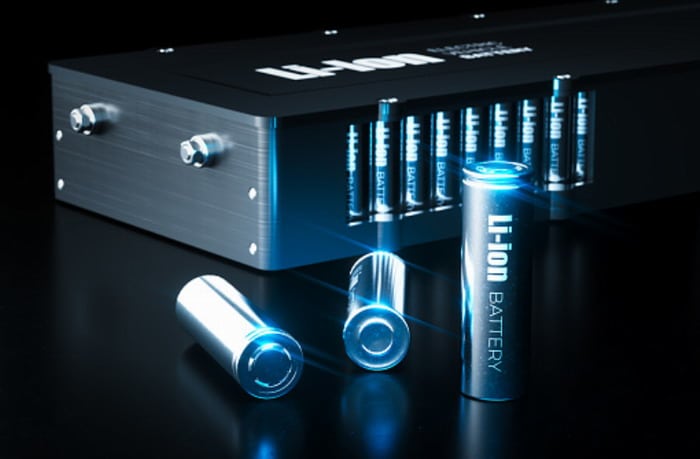Pros and Cons of Lithium Ion Batteries

Lithium-ion batteries have become an indispensable part of modern life, powering everything from smartphones to electric vehicles. They are the most popular type of rechargeable battery in use today, and for good reason: they offer a high energy density, long life, and low self-discharge rate. However, like any technology, this technology has its pros and cons. Let’s see what are the pros and cons of lithium ion batteries.
Pros of Lithium Ion Batteries
Being a technology used in everyday life, lithium ion batteries have more pros than cons.
High energy density
Lithium-ion batteries are popular due to their high energy density, which means they can store a lot of energy in a small size. This is due to the unique chemistry of the battery. Lithium ions move between the positive and negative electrodes during charging and discharging, which creates a flow of electrical current. Lithium is an extremely light metal, and when it is paired with other lightweight metals such as cobalt, nickel, or manganese, it creates a battery that is both small and powerful.
Additionally, the lithium-ion battery has a very high voltage and a low self-discharge rate, allowing it to store energy for long periods of time without losing power. High energy density has made lithium-ion batteries the go-to power source for portable electronics, electric vehicles, and other applications where size and weight are important factors.
Recyclable
While they do have a limited life span, they are also recyclable since they fall under e-waste! Nevertheless, the advancements in the manufacturing process are extending the life span of the newest models of lithium batteries, as discussed below.
However, lithium batteries shouldn’t go with other items you put in the recycling bin because they have a specific battery recycling process for environmental safety. They can leach toxic chemicals during landfill disposal, causing pollution and adverse health effects.
Did you know that lithium batteries contain hard-to-mine raw materials? Lithium batteries have lithium, nickel, cobalt, and manganese, which are difficult to find and manufacture. Therefore, recycling lithium batteries is an excellent way to extract these raw materials and convert them into other products.
However, not all recycling facilities don’t have the equipment and capabilities to recycle lithium batteries. Hence, sending lithium batteries to a certified electronics recycler is advisable. A good recycling facility has certificates and other documents proving they’re a dependable, environmentally friendly agency.
The recycling facility determines the type of battery and its contents for proper sorting. Experts identify what chemicals and minerals are recyclable. The recycler discharges the lithium battery to remove the electricity for a safe recycling process.
Long life
Lithium-ion batteries are known for their long lifespan, which is one of the reasons why they are so popular as a rechargeable battery source. There are a few key factors that contribute to this longevity.
Firstly, the chemistry of lithium-ion batteries is designed to minimize the wear and tear that occurs during charging and discharging. The electrodes are made from materials that are less likely to degrade over time, and the lithium ions themselves are able to move between the electrodes with minimal resistance. This reduces the amount of heat generated within the battery, which can be a major cause of damage over time.
Secondly, manufacturers of lithium-ion batteries have developed sophisticated charging algorithms that optimize the battery’s performance and reduce the risk of overcharging or undercharging. Overcharging can cause the battery to degrade faster, while undercharging can reduce its capacity and lifespan. By carefully monitoring the battery’s state of charge and adjusting the charging rate accordingly, these algorithms can extend the battery’s life significantly.
Finally, improvements in manufacturing processes and quality control have helped to ensure that lithium-ion batteries are built to last. By using high-quality materials and ensuring that the battery is assembled correctly, manufacturers are able to reduce the risk of defects that could lead to premature failure.
All of these factors work together to give lithium-ion batteries a long lifespan, making them ideal for use in applications where reliability is crucial. Whether you’re using a lithium-ion battery to power your smartphone or your electric car, you can be confident that it will last for years to come.
Low self-discharge rate
One of the major advantages of lithium-ion batteries is their low self-discharge rate. This means that they can hold their charge for extended periods of time, even when not in use. There are a few reasons why lithium-ion batteries are able to achieve this.
This is due to the chemistry of lithium-ion batteries, which are designed to minimize the loss of charge when the battery is not in use, due to advances in manufacturing techniques that have helped reduce the amount of impurities in the battery materials, which can cause self-discharge, and finally, due to the use of sophisticated battery management systems (BMS) can help to optimize the charging and discharging of lithium-ion batteries.
Environmentally friendly
Lithium-ion batteries are more environmentally friendly compared to other types of batteries, and there are a few reasons why this is the case.
They don’t contain any toxic heavy metals such as lead or cadmium, which can be harmful to the environment and human health, they are highly efficient, which means that they require less energy to charge and discharge compared to other types of batteries, and finally, advances in battery recycling technology have made it easier to recycle lithium-ion batteries.
Fast charging
Lithium-ion batteries are known for their fast charging capabilities, which is one of the key reasons why they are so popular as a rechargeable battery source. There are a few factors that contribute to their ability to charge quickly.

LFB battery used by Tesla in Model 3 and Model Y, image source: Pixabay
Cons of Lithium Ion Batteries
Like any technology available on the planet, lithium ion batteries have a few cons.
Flammability
One of the key concerns with lithium-ion batteries is their flammability. If a lithium-ion battery is damaged or improperly charged, it can overheat and potentially catch fire or even explode.
This is because lithium-ion batteries contain a flammable electrolyte, which is a liquid or gel substance that conducts electricity between the battery’s positive and negative electrodes. If the battery is punctured, crushed, or exposed to high temperatures, the electrolyte can leak out and ignite, causing a fire or explosion.
To minimize the risk of flammability, lithium-ion batteries are designed with various safety features. For example, they may include a pressure relief valve that allows gases to escape in the event of an overcharge or overheating. They may also include a temperature sensor that shuts down the battery if it gets too hot.
Additionally, manufacturers and regulatory agencies have developed guidelines for the safe use and transportation of lithium-ion batteries. For example, lithium-ion batteries are typically required to be shipped in special packaging that can contain a fire or explosion, and users are advised to only use charging adapters and accessories that are approved by the battery manufacturer.
Limited lifespan
While lithium-ion batteries are known for their high energy density and long life compared to other types of batteries, they do have a limited lifespan.
The lifespan of a lithium-ion battery depends on several factors, including the frequency and depth of discharge, the temperature at which it is operated, and the number of charge-discharge cycles it undergoes.
Over time, lithium-ion batteries lose their ability to hold a charge, which can result in reduced performance and ultimately, the need for replacement. In addition, high temperatures can accelerate the aging process and shorten the battery’s lifespan.
To maximize the lifespan of a lithium-ion battery, it is important to use it in a way that minimizes stress on the battery. This can include avoiding deep discharges, charging the battery before it reaches a low charge level, and storing the battery in a cool, dry place.
Expensive
Lithium-ion batteries are generally more expensive than other types of batteries, mostly because the materials used in these batteries are relatively expensive. The cathode and anode of the battery are typically made from rare metals such as cobalt, nickel, and lithium, which are costly to mine and refine.
The manufacturing process for lithium-ion batteries is complex and requires specialized equipment and expertise. This adds to the cost of production and results in a higher price for the end product.
The demand for lithium-ion batteries has increased significantly in recent years, particularly in applications such as electric vehicles and energy storage systems. This increased demand has put pressure on the supply chain, resulting in higher prices for raw materials and components.
Capacity degradation
One of the main concerns with lithium-ion batteries is capacity degradation, which refers to the gradual loss of the battery’s ability to hold a charge over time.
One of the primary causes is the formation of a solid electrolyte interface (SEI) on the surface of the battery’s electrodes. This layer forms naturally as the battery is charged and discharged, and over time it can reduce the battery’s capacity.
Another factor that contributes to capacity degradation is the loss of active lithium ions from the cathode material. This can occur as a result of repeated charge-discharge cycles, high temperatures, or exposure to moisture or other contaminants.
To mitigate capacity degradation in lithium-ion batteries, manufacturers have developed various strategies. One approach is to use materials with higher energy density and better stability, such as lithium iron phosphate (LFP) or lithium titanate (LTO). Another strategy is to use battery management systems (BMS) that can optimize the charging and discharging of the battery to minimize stress on the cells and extend their lifespan.
Recycling
Recycling of lithium-ion batteries is an important process that helps to recover valuable materials and reduce the environmental impact of these batteries.
Lithium-ion batteries can be recycled to recover materials such as lithium, cobalt, nickel, and copper. These materials can then be used to produce new batteries or other products, reducing the need for mining and production of new materials.
Recycling of lithium-ion batteries is still relatively new and not yet widely implemented. However, as the demand for these batteries continues to grow, there is increasing focus on developing efficient and cost-effective recycling processes.
In addition to the environmental benefits, recycling of lithium-ion batteries also has economic benefits. By recovering valuable materials, recycling can reduce the cost of production for new batteries and provide a source of revenue for companies involved in the recycling process.
Conclusion
In conclusion, lithium-ion batteries have several pros and cons. While they offer high energy density, low self-discharge rate, long cycle life, and fast charging, they also have a high cost, risk of overheating, limited lifespan, environmental concerns, and complex manufacturing process. It is important to consider these factors when deciding whether to use lithium-ion batteries in a device or system.







